Subject-Verb Agreement[下学期]
文档属性
| 名称 | Subject-Verb Agreement[下学期] | 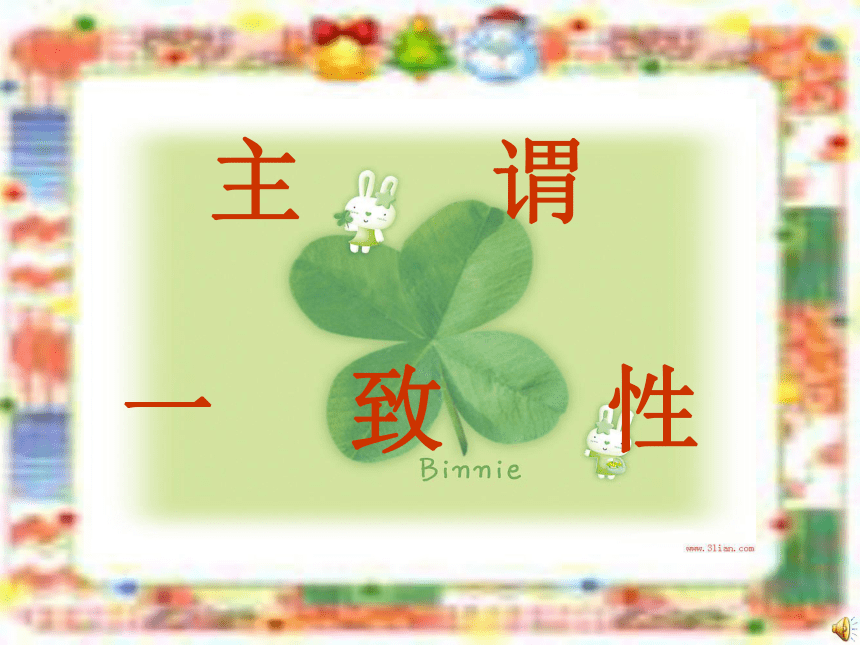 | |
| 格式 | rar | ||
| 文件大小 | 2.2MB | ||
| 资源类型 | 教案 | ||
| 版本资源 | 通用版 | ||
| 科目 | 英语 | ||
| 更新时间 | 2006-06-06 09:29:00 | ||
图片预览

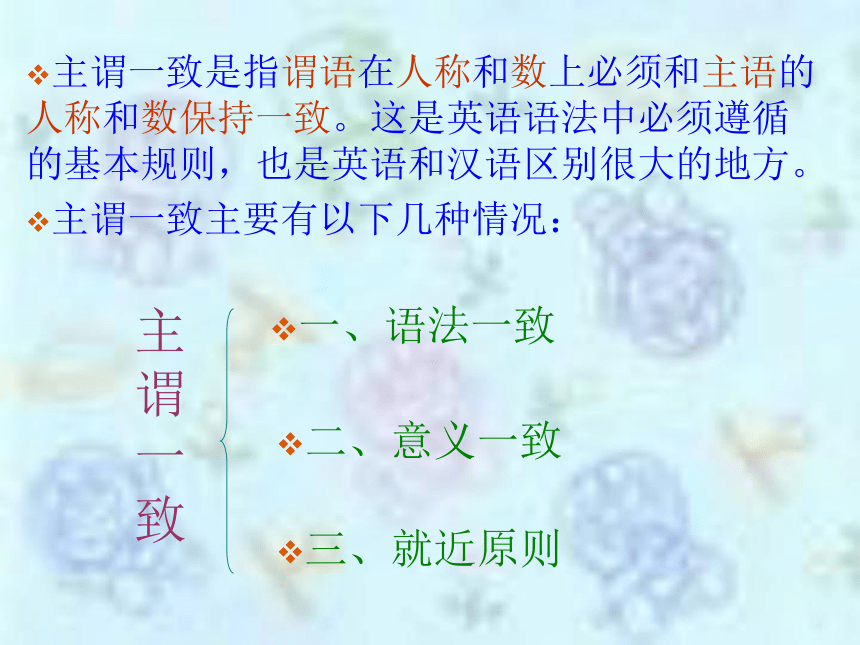
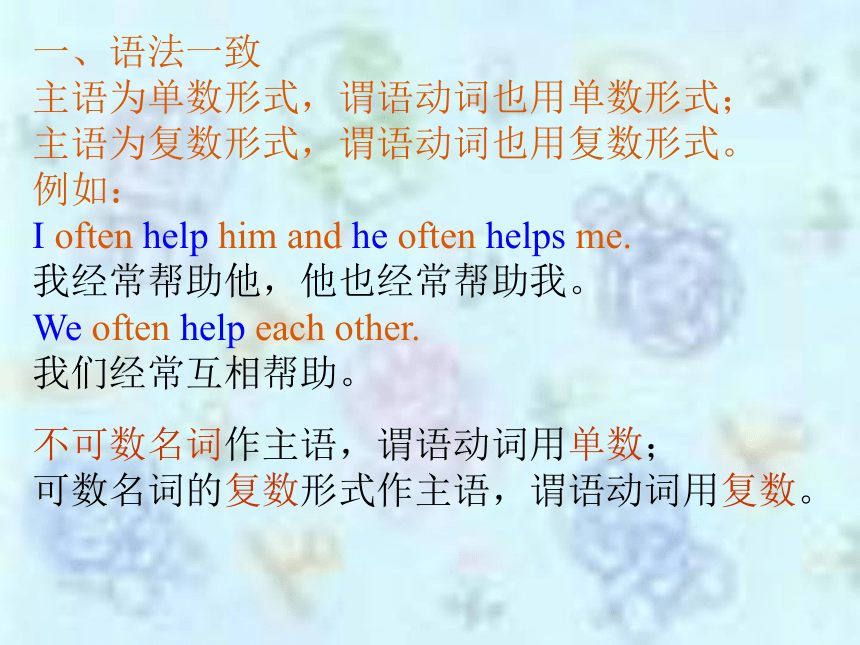
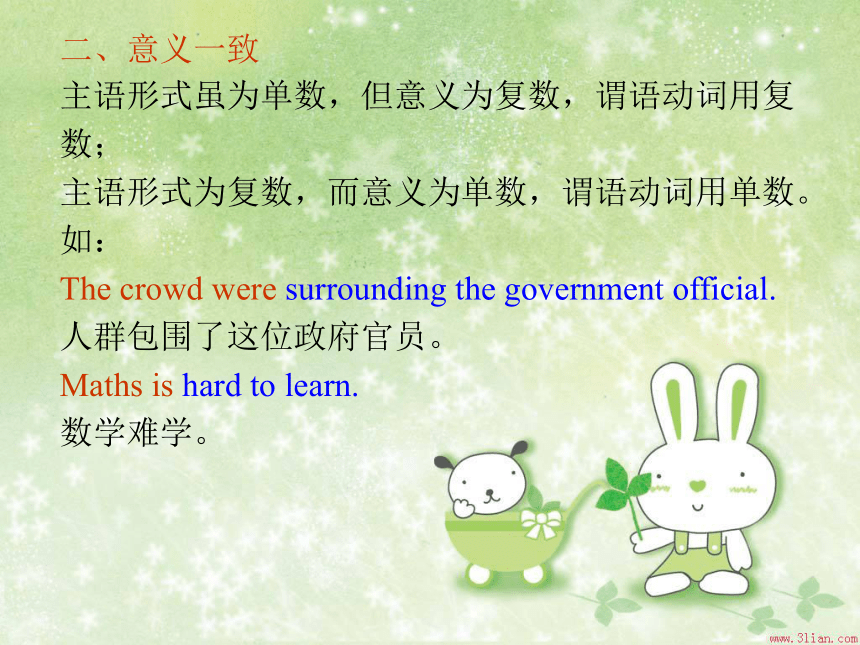
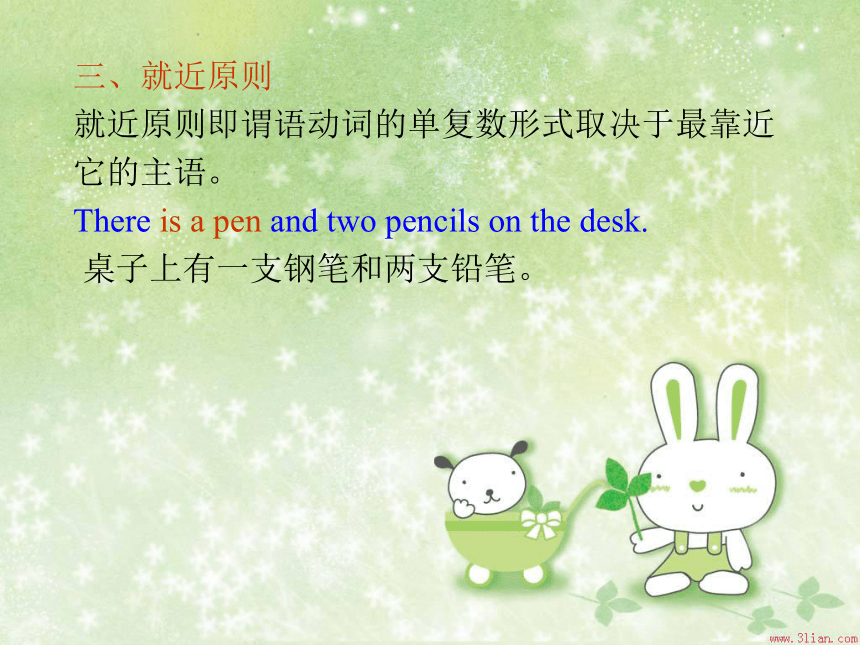
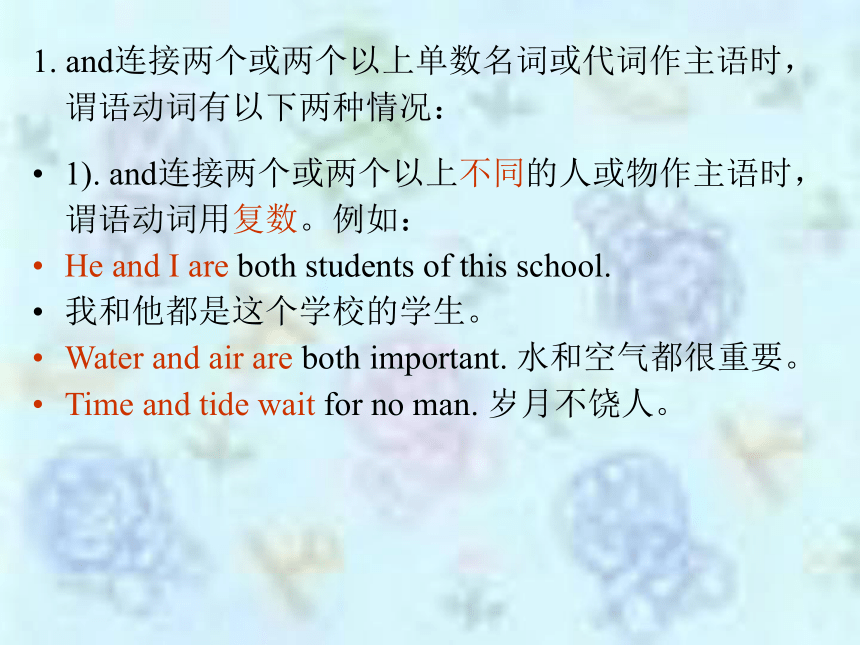
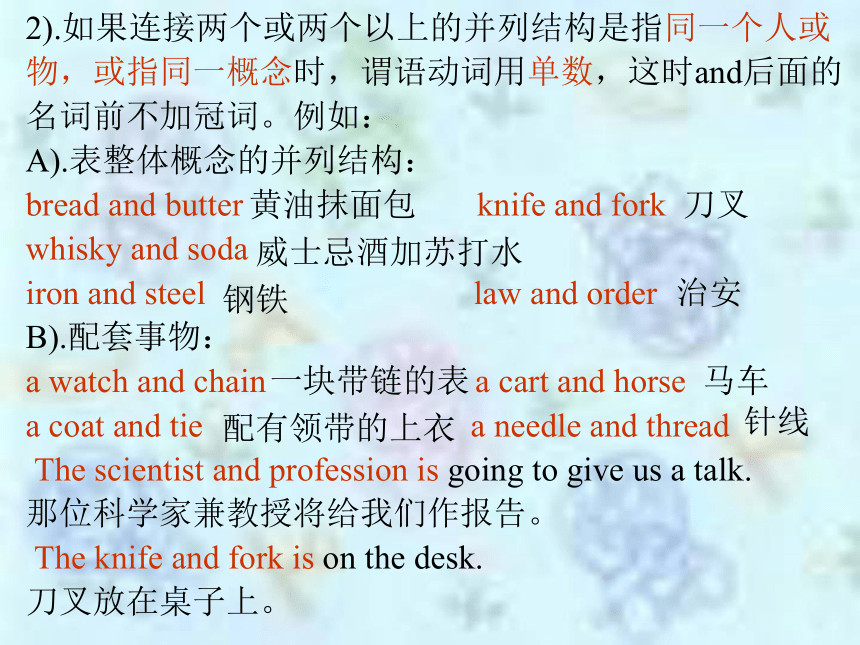

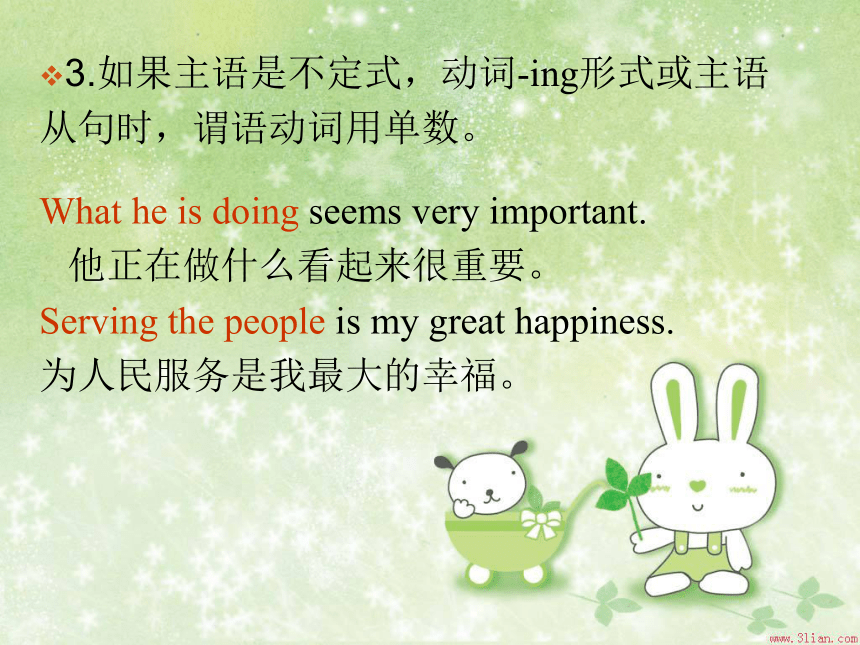
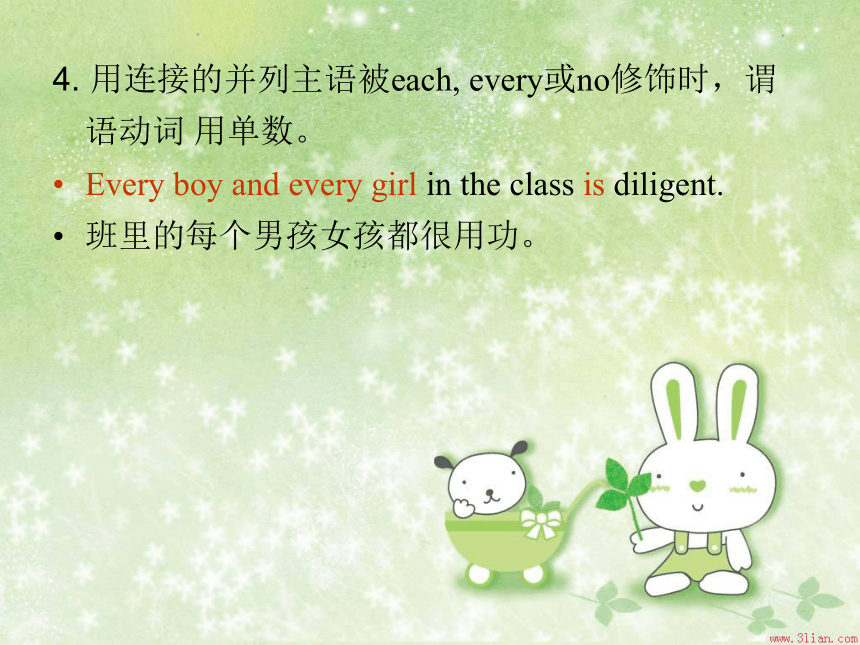
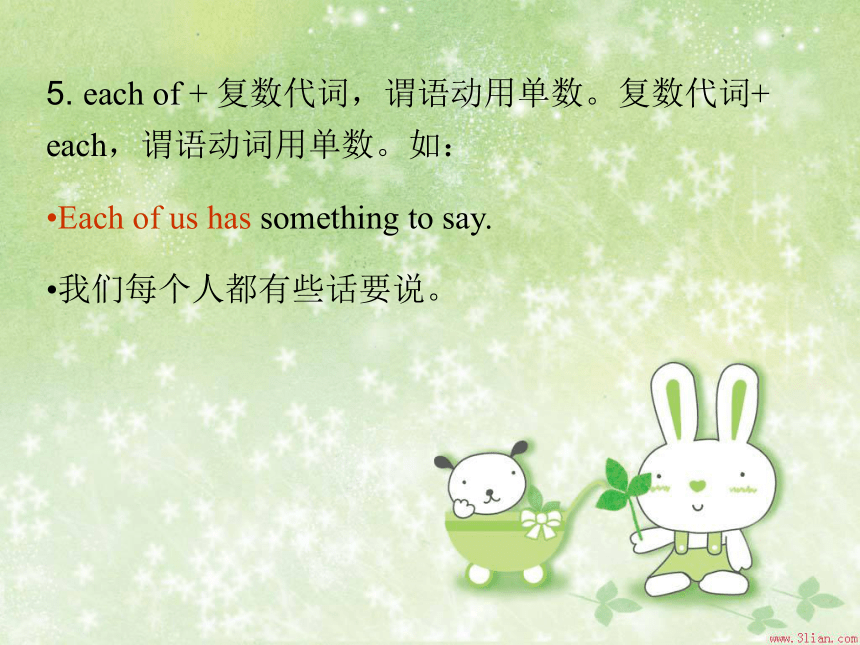
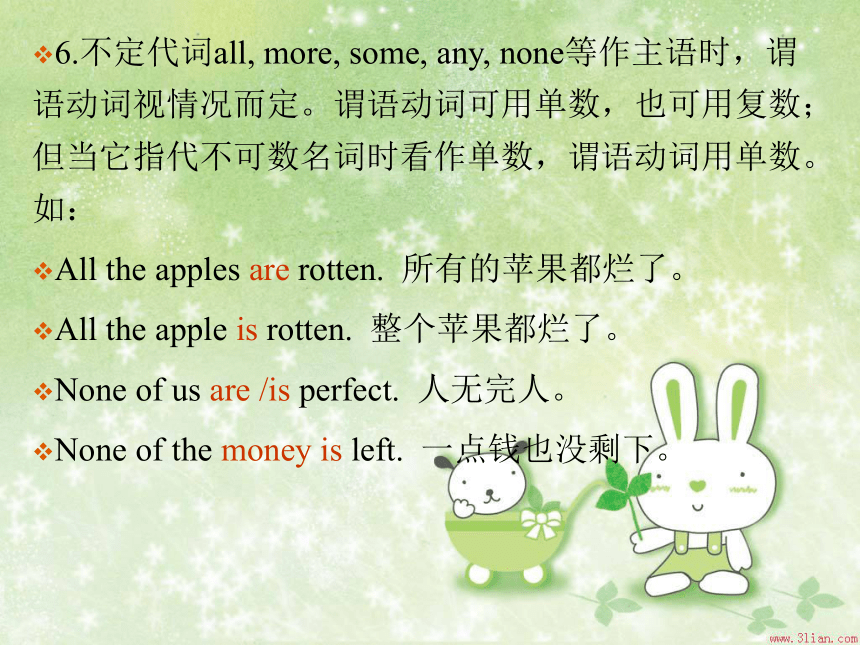
文档简介
课件32张PPT。 主 谓
一 致 性主谓一致性主谓一致主谓一致是指谓语在人称和数上必须和主语的人称和数保持一致。这是英语语法中必须遵循的基本规则,也是英语和汉语区别很大的地方。
主谓一致主要有以下几种情况:二、意义一致三、就近原则一、语法一致一、语法一致
主语为单数形式,谓语动词也用单数形式;
主语为复数形式,谓语动词也用复数形式。
例如:
I often help him and he often helps me.
我经常帮助他,他也经常帮助我。
We often help each other.
我们经常互相帮助。
不可数名词作主语,谓语动词用单数;
可数名词的复数形式作主语,谓语动词用复数。二、意义一致
主语形式虽为单数,但意义为复数,谓语动词用复数;
主语形式为复数,而意义为单数,谓语动词用单数。如:
The crowd were surrounding the government official.
人群包围了这位政府官员。
Maths is hard to learn.
数学难学。三、就近原则
就近原则即谓语动词的单复数形式取决于最靠近它的主语。
There is a pen and two pencils on the desk.
桌子上有一支钢笔和两支铅笔。1. and连接两个或两个以上单数名词或代词作主语时,谓语动词有以下两种情况:
1). and连接两个或两个以上不同的人或物作主语时,谓语动词用复数。例如:
He and I are both students of this school.
我和他都是这个学校的学生。
Water and air are both important. 水和空气都很重要。
Time and tide wait for no man. 岁月不饶人。
2).如果连接两个或两个以上的并列结构是指同一个人或物,或指同一概念时,谓语动词用单数,这时and后面的名词前不加冠词。例如:
A).表整体概念的并列结构:
bread and butter knife and fork
whisky and soda
iron and steel law and order
B).配套事物:
a watch and chain a cart and horse
a coat and tie a needle and thread
The scientist and profession is going to give us a talk.
那位科学家兼教授将给我们作报告。
The knife and fork is on the desk.
刀叉放在桌子上。黄油抹面包刀叉威士忌酒加苏打水钢铁治安一块带链的表马车针线配有领带的上衣2.主语后面带有with, along with, together with, as well as, besides, like, without, except, including, but等引导的短语时,谓语动词必须与前面的主语在人称和数上保持一致。例如:
The teacher, together with his students, is planting trees in the garden. 老师和同学们正在花园里种树。
No one except us knows about it. 除了我们没人知道这件事。
All the students, including Mary, are playing basketball on the playground. 包括玛丽在内所有的学生都在操场上打篮球。3.如果主语是不定式,动词-ing形式或主语从句时,谓语动词用单数。
What he is doing seems very important.
他正在做什么看起来很重要。
Serving the people is my great happiness.
为人民服务是我最大的幸福。4. 用连接的并列主语被each, every或no修饰时,谓语动词 用单数。
Every boy and every girl in the class is diligent.
班里的每个男孩女孩都很用功。5. each of + 复数代词,谓语动用单数。复数代词+ each,谓语动词用单数。如:
Each of us has something to say.
我们每个人都有些话要说。6.不定代词all, more, some, any, none等作主语时,谓语动词视情况而定。谓语动词可用单数,也可用复数;但当它指代不可数名词时看作单数,谓语动词用单数。如:
All the apples are rotten. 所有的苹果都烂了。
All the apple is rotten. 整个苹果都烂了。
None of us are /is perfect. 人无完人。
None of the money is left. 一点钱也没剩下。7.复合不定代词作主语时,谓语动词用单数。
Someone is calling you.
有人叫你。
Nothing is found in the room.
在屋里找不到什么东西。8. 名词如trousers, scissors, clothes, goods, glasses 等作主语时,谓语动词必须用复数;
而形复义单的名词如news;以-ics结尾的学科名称如physics, mathematics /maths, economics, politics, 国名如the United States;报纸名如the New Times;书名如Arabian Nights (《天方夜谭》), Great Expectations(《远大前程》);以及the United Nations作主语时,谓语动词用单数。
The scissors are sharp.
No news is good news.
Great Expectations was written by Charles Dickens in 1860.9.集体名词作主语,谓语动词可用单数,也可用复数,主要由句子的意思决定。强调整体时用单数,强调整体中的个体的用复数。这类名词有people, family, class, population, crowd, team, ground等。如:
His family is going out. 他们全家要外出。
His family are all music lovers. 他们全家都是音乐爱好者。10.有些名词单复数形式相同,作主语时,谓语动词由上下文决定。这类名词有means, deer, sheep, Chinese, Japanese, fish等。如:
Not every means is useful. 并非每种方法都有效。
Not all means are useful.并非所有的方法都有效。
11. 表示一类人的“the +形容词(分词)”作主语时,谓语动词用复数。如:
The sick in the accident have been taken to the hospital.
The lost have been found.12.表示时间、金钱、距离、度量等名词作主语时,不管单复数形式,其谓语动词用单数。如:
Thirty years is not a long time.
30年的时间并不长。
Two hours is enough for me to finish the work.
两个小时对我来说完成这项工作足够了。13. the rest of, half of, majority of, part of, a lot of, lots of, one of, a number of, a plenty of, percent of以及分数词等作主语时,谓语动词的单复数取决于后面名词的数,即就近原则。如:
A part of the students have arrived.部分学生已到了。
A part of the apple has been eaten by the mouse.这个苹果的一部分被老鼠吃了。
More than 70 percent of the surface of the earth is covered by water. 地球表面有百分之七十多被水覆盖着。
Twenty percent of the workers in the factory are women. 这个工厂里有百分之二十是女工。14. 在表存在的there be 句式中,主语是两个或多个并列名词(短语),be的形式与最近的一个名词(短语)保持一致。
There is a pen, two pencils and several books on the desk.
=There are two pencils , a pen and several books on the desk.
=There are several books , a pen and two pencils on the desk.15.由here, there等引导的倒装句中,若主语不止一个时,谓语动词与最近的主语保持一致。如:
Here comes the bus.
Here is a pen and two books for you.16.用连词or, either…or, neither…nor, not only…but also等连接并列主语时,谓语动词应与最近的主语保持一致。如:
Neither you nor I am wrong.
Neither I nor you are wrong.
Not only the students but also the teacher enjoys listening to the music.
Not only the teacher but also the students enjoy listening to the music.Let’s have a try!P5 Discovering useful structures:
Answer key for Ex1:
1. is, are
2. has, is
3. is, were
4. was, wereP5 Ex2 Fill in the correct verb form in this letter.
Dear Xiaoyu,
I think everyone (is /are) settled in London, although neither the weather nor the food (is /are) good. Either rain or snow fell every day this week but everybody (has /have) tried to ignore it. My friends and my mother (has /have) visited the theater almost every night. None of them (carry /carries) an umbrella but nobody (has /have) let that affect their activities. We are enjoying ourselves so much that I wonder if anybody (want /wants) to come home. This group of tourists (love /loves) the culture and (is /are) happy in England and would like to visit London every summer!
See you soon
Dong Xianshun__________________________________________
2. C3. D4. A5. B6. B7. D8. C9. A10. B1. BP43 Discovering useful structures:
Answer key for Ex1:P44 Ex2:
1. Class Two (have /has) 22 students. (It /They) (is /are) a small class. The class (have /has) a map, which is on the back wall of (its /their) classroom.________________________P44 Ex2:
2. After the lecture the audience (is /are) divided into two groups. One group (is /are) very young, and nobody (is /are) older than eighteen. The other group (is /are) their parents. Both the groups (is / are) discussing the problem of the generation gap. Neither (is /are) sure that (he or she /they) can understand each other well. But none (thinks /think) that there (is /are) anything that cannot be solved between them. All the trouble (comes /come) from (his /their) misunderstandings. So what (is / are) most important (is/ are) understanding in a family. It is the same with a team or a company. A football team (plays/ play) very well if (it /they) (understands /understand) each other well. A company (becomes /become) a big family for the same reason.__________________________________________________________________________________________ Multiple choice:
1. On the wall______ two large portraits.
A. hangs B. hang C. hanged D. hanging
2. “News of victories _____ pouring in as our army advances,”
the company commander said.
A. keep B. keeps C. kept D. have kept
3. There _____ a lot of milk in the bottle.
A. are B. is C. were D. has
4. Zhang’s family ____ rather big, with twelve people in all.
A. is B. are C. being D. was
5. Nobody but Jane ____ the secret.
A. know B. knows C. have known D. is knownBBBBA6. All but one _____ here just now.
A. is B. was C. has been D. were
7. A library with five thousand books ____ to the nation as a gift.
A. is offered B. has offered
C. are offered D. have offered
8. Not only I but also Jane and Mary __ tired of having one exam after another.
A. is B. are C. am D. be
9. The number of people invited ____ fifty, but a number of them ____ absent for different reasons.
A. were; was B. was; was C. was; were D. were; were DABC10. When and where to build the new factory _____ yet.
A. is not decided B. are not decided
C. has not decided D. have not decided
11. A library with five thousand books____ to the nation as a gift.
A. is offered B. has offered C. are offered D. have offered
12. Not only I but also Jane and Mary ____ tired of having one examination after another.
A. is B. are C. am D. be
13. All but one ____ here just now.
A. is B.was C. has been D. wereAABDHave a restP41 listening:
1. Because at that time women were not allowed to be soldiers.
2. The church thought Joan had not behaved as a woman should.
3. They did not have leaders to inspire them or who had good ideas for winning battles.
4. Because she had many good ideas for attacking the enemy. She had shown them that they could win if they fought well and a good plan for the battle. Even after she died, her spirit inspired the French army who ended the English rule in France at last.
5. The church made her a saint.
一 致 性主谓一致性主谓一致主谓一致是指谓语在人称和数上必须和主语的人称和数保持一致。这是英语语法中必须遵循的基本规则,也是英语和汉语区别很大的地方。
主谓一致主要有以下几种情况:二、意义一致三、就近原则一、语法一致一、语法一致
主语为单数形式,谓语动词也用单数形式;
主语为复数形式,谓语动词也用复数形式。
例如:
I often help him and he often helps me.
我经常帮助他,他也经常帮助我。
We often help each other.
我们经常互相帮助。
不可数名词作主语,谓语动词用单数;
可数名词的复数形式作主语,谓语动词用复数。二、意义一致
主语形式虽为单数,但意义为复数,谓语动词用复数;
主语形式为复数,而意义为单数,谓语动词用单数。如:
The crowd were surrounding the government official.
人群包围了这位政府官员。
Maths is hard to learn.
数学难学。三、就近原则
就近原则即谓语动词的单复数形式取决于最靠近它的主语。
There is a pen and two pencils on the desk.
桌子上有一支钢笔和两支铅笔。1. and连接两个或两个以上单数名词或代词作主语时,谓语动词有以下两种情况:
1). and连接两个或两个以上不同的人或物作主语时,谓语动词用复数。例如:
He and I are both students of this school.
我和他都是这个学校的学生。
Water and air are both important. 水和空气都很重要。
Time and tide wait for no man. 岁月不饶人。
2).如果连接两个或两个以上的并列结构是指同一个人或物,或指同一概念时,谓语动词用单数,这时and后面的名词前不加冠词。例如:
A).表整体概念的并列结构:
bread and butter knife and fork
whisky and soda
iron and steel law and order
B).配套事物:
a watch and chain a cart and horse
a coat and tie a needle and thread
The scientist and profession is going to give us a talk.
那位科学家兼教授将给我们作报告。
The knife and fork is on the desk.
刀叉放在桌子上。黄油抹面包刀叉威士忌酒加苏打水钢铁治安一块带链的表马车针线配有领带的上衣2.主语后面带有with, along with, together with, as well as, besides, like, without, except, including, but等引导的短语时,谓语动词必须与前面的主语在人称和数上保持一致。例如:
The teacher, together with his students, is planting trees in the garden. 老师和同学们正在花园里种树。
No one except us knows about it. 除了我们没人知道这件事。
All the students, including Mary, are playing basketball on the playground. 包括玛丽在内所有的学生都在操场上打篮球。3.如果主语是不定式,动词-ing形式或主语从句时,谓语动词用单数。
What he is doing seems very important.
他正在做什么看起来很重要。
Serving the people is my great happiness.
为人民服务是我最大的幸福。4. 用连接的并列主语被each, every或no修饰时,谓语动词 用单数。
Every boy and every girl in the class is diligent.
班里的每个男孩女孩都很用功。5. each of + 复数代词,谓语动用单数。复数代词+ each,谓语动词用单数。如:
Each of us has something to say.
我们每个人都有些话要说。6.不定代词all, more, some, any, none等作主语时,谓语动词视情况而定。谓语动词可用单数,也可用复数;但当它指代不可数名词时看作单数,谓语动词用单数。如:
All the apples are rotten. 所有的苹果都烂了。
All the apple is rotten. 整个苹果都烂了。
None of us are /is perfect. 人无完人。
None of the money is left. 一点钱也没剩下。7.复合不定代词作主语时,谓语动词用单数。
Someone is calling you.
有人叫你。
Nothing is found in the room.
在屋里找不到什么东西。8. 名词如trousers, scissors, clothes, goods, glasses 等作主语时,谓语动词必须用复数;
而形复义单的名词如news;以-ics结尾的学科名称如physics, mathematics /maths, economics, politics, 国名如the United States;报纸名如the New Times;书名如Arabian Nights (《天方夜谭》), Great Expectations(《远大前程》);以及the United Nations作主语时,谓语动词用单数。
The scissors are sharp.
No news is good news.
Great Expectations was written by Charles Dickens in 1860.9.集体名词作主语,谓语动词可用单数,也可用复数,主要由句子的意思决定。强调整体时用单数,强调整体中的个体的用复数。这类名词有people, family, class, population, crowd, team, ground等。如:
His family is going out. 他们全家要外出。
His family are all music lovers. 他们全家都是音乐爱好者。10.有些名词单复数形式相同,作主语时,谓语动词由上下文决定。这类名词有means, deer, sheep, Chinese, Japanese, fish等。如:
Not every means is useful. 并非每种方法都有效。
Not all means are useful.并非所有的方法都有效。
11. 表示一类人的“the +形容词(分词)”作主语时,谓语动词用复数。如:
The sick in the accident have been taken to the hospital.
The lost have been found.12.表示时间、金钱、距离、度量等名词作主语时,不管单复数形式,其谓语动词用单数。如:
Thirty years is not a long time.
30年的时间并不长。
Two hours is enough for me to finish the work.
两个小时对我来说完成这项工作足够了。13. the rest of, half of, majority of, part of, a lot of, lots of, one of, a number of, a plenty of, percent of以及分数词等作主语时,谓语动词的单复数取决于后面名词的数,即就近原则。如:
A part of the students have arrived.部分学生已到了。
A part of the apple has been eaten by the mouse.这个苹果的一部分被老鼠吃了。
More than 70 percent of the surface of the earth is covered by water. 地球表面有百分之七十多被水覆盖着。
Twenty percent of the workers in the factory are women. 这个工厂里有百分之二十是女工。14. 在表存在的there be 句式中,主语是两个或多个并列名词(短语),be的形式与最近的一个名词(短语)保持一致。
There is a pen, two pencils and several books on the desk.
=There are two pencils , a pen and several books on the desk.
=There are several books , a pen and two pencils on the desk.15.由here, there等引导的倒装句中,若主语不止一个时,谓语动词与最近的主语保持一致。如:
Here comes the bus.
Here is a pen and two books for you.16.用连词or, either…or, neither…nor, not only…but also等连接并列主语时,谓语动词应与最近的主语保持一致。如:
Neither you nor I am wrong.
Neither I nor you are wrong.
Not only the students but also the teacher enjoys listening to the music.
Not only the teacher but also the students enjoy listening to the music.Let’s have a try!P5 Discovering useful structures:
Answer key for Ex1:
1. is, are
2. has, is
3. is, were
4. was, wereP5 Ex2 Fill in the correct verb form in this letter.
Dear Xiaoyu,
I think everyone (is /are) settled in London, although neither the weather nor the food (is /are) good. Either rain or snow fell every day this week but everybody (has /have) tried to ignore it. My friends and my mother (has /have) visited the theater almost every night. None of them (carry /carries) an umbrella but nobody (has /have) let that affect their activities. We are enjoying ourselves so much that I wonder if anybody (want /wants) to come home. This group of tourists (love /loves) the culture and (is /are) happy in England and would like to visit London every summer!
See you soon
Dong Xianshun__________________________________________
2. C3. D4. A5. B6. B7. D8. C9. A10. B1. BP43 Discovering useful structures:
Answer key for Ex1:P44 Ex2:
1. Class Two (have /has) 22 students. (It /They) (is /are) a small class. The class (have /has) a map, which is on the back wall of (its /their) classroom.________________________P44 Ex2:
2. After the lecture the audience (is /are) divided into two groups. One group (is /are) very young, and nobody (is /are) older than eighteen. The other group (is /are) their parents. Both the groups (is / are) discussing the problem of the generation gap. Neither (is /are) sure that (he or she /they) can understand each other well. But none (thinks /think) that there (is /are) anything that cannot be solved between them. All the trouble (comes /come) from (his /their) misunderstandings. So what (is / are) most important (is/ are) understanding in a family. It is the same with a team or a company. A football team (plays/ play) very well if (it /they) (understands /understand) each other well. A company (becomes /become) a big family for the same reason.__________________________________________________________________________________________ Multiple choice:
1. On the wall______ two large portraits.
A. hangs B. hang C. hanged D. hanging
2. “News of victories _____ pouring in as our army advances,”
the company commander said.
A. keep B. keeps C. kept D. have kept
3. There _____ a lot of milk in the bottle.
A. are B. is C. were D. has
4. Zhang’s family ____ rather big, with twelve people in all.
A. is B. are C. being D. was
5. Nobody but Jane ____ the secret.
A. know B. knows C. have known D. is knownBBBBA6. All but one _____ here just now.
A. is B. was C. has been D. were
7. A library with five thousand books ____ to the nation as a gift.
A. is offered B. has offered
C. are offered D. have offered
8. Not only I but also Jane and Mary __ tired of having one exam after another.
A. is B. are C. am D. be
9. The number of people invited ____ fifty, but a number of them ____ absent for different reasons.
A. were; was B. was; was C. was; were D. were; were DABC10. When and where to build the new factory _____ yet.
A. is not decided B. are not decided
C. has not decided D. have not decided
11. A library with five thousand books____ to the nation as a gift.
A. is offered B. has offered C. are offered D. have offered
12. Not only I but also Jane and Mary ____ tired of having one examination after another.
A. is B. are C. am D. be
13. All but one ____ here just now.
A. is B.was C. has been D. wereAABDHave a restP41 listening:
1. Because at that time women were not allowed to be soldiers.
2. The church thought Joan had not behaved as a woman should.
3. They did not have leaders to inspire them or who had good ideas for winning battles.
4. Because she had many good ideas for attacking the enemy. She had shown them that they could win if they fought well and a good plan for the battle. Even after she died, her spirit inspired the French army who ended the English rule in France at last.
5. The church made her a saint.
